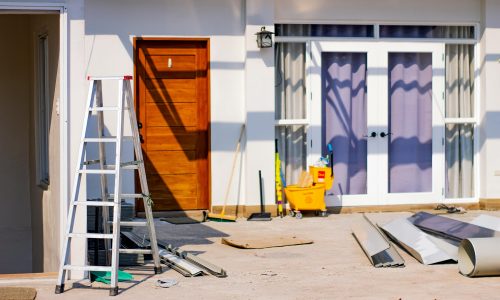
How to Pay for Home Remodeling Projects

Most homeowners realize the benefits of home remodeling projects. The most important benefits that come with remodeling your home include an increase in home value and better curb appeal. But you may be worried about how much these projects will cost you. According to Home Advisor, the typical range for a home remodeling project is between $17,917 and $78,032. Even if the cost of your project is on the lower end, you might not have sufficient savings to cover all the expenses. This brings us to the question of how to pay for home remodeling. Here are some potential solutions that might work for you.
Use Available Cash
If you’re wondering how to pay for home remodeling, why not start by considering your cash reserves. Truth be told, cash is always king. That’s because when you’re using your available cash, you’re paying for something that you can actually afford, and you don’t have to worry about going into debt. Sure, home remodeling can transform your home into a beautiful space, but you may end up not enjoying it if there’s a big load of debt weighing your budget down. On the other hand, and as mentioned, not many people have a lot of cash lying around, waiting for the moment you decide to invest in a new garage door or siding installation.
Whatever you decide, you have to weigh the pros and cons of paying for cash. Assess your situation carefully because your financial circumstances are unique. If you have a large sum of cash burning a hole in your pocket, then, by all means, use it to pay for your home remodeling. However, if you don’t have a lot of cash available right now, you might be limited to only smaller projects. In addition, you might end up dipping into your rainy day fund or using up all your disposable cash, thus messing up your cash flow. All this can leave you with insufficient funds to cover daily living expenses.
Home Improvement Loan

While it’s true that cash is king, sometimes you can’t afford to wait to start creating your dream home. The good news is that when you borrow the right way, this can help you realize your goal sooner rather than later. If you’ve decided how to pay for home remodeling and you plan to borrow, there is a wide range of financial products at your disposal. One of the most popular financial products you can use to cover home improvement expenses is a home improvement loan. A home improvement loan is a type of personal loan. Generally, personal loans can be used for a wide range of legitimate purposes, such as paying for your wedding, holiday, and travel or upgrading your home appliances.
Sometimes, the banks categorize personal loans according to what they will be used for, so you can apply for a home improvement loan. This is a flexible loan that you can use for all kinds of home improvement projects. Let’s say you want to repair your roof. A home improvement loan can cover the cost of hiring roofing contractors. Besides paying roofers, you can also use the money for small-size remodeling projects like painting, upgrading light fixtures, and buying new furniture. However, keep in mind that a home improvement loan is unsecured because you’re not required to provide security or collateral for the loan. This increases the risk for the lender, so they will likely charge a higher interest rate or restrict borrowing limits and repayment periods.
Home Equity Loan
When it comes to how to pay for home remodeling, you also have to consider the budget for your project. If you’re considering a whole home remodeling project or a second-story addition, you’ll need a considerable amount of money. In that case, it’s better to take out a secured loan, namely a home equity loan, which is also known as a second mortgage. A home equity loan is the best option if you have built up enough equity in your home. Equity refers to the difference between how much you owe on your home and the real value of your home. You can use this equity as collateral to get a secured loan from your mortgage lender.
The biggest advantage of this type of loan is that, because the loan is secured, this reduces the lender’s risk. The lender, therefore, is more willing to lend you money at a lower interest rate, and they will also increase your borrowing limits. This makes a home equity loan suitable for large products. For instance, instead of repairing your roof, you can now hire professional roofers to install your roof. Depending on the type of roof you wish to install, you’ll have to look for roofing companies that specialize in the type of roofing material you have in mind.
If you want to install a metal roof which typically costs more than an asphalt roof, then you have to hire a metal roof installer. Fortunately, a home equity loan should be able to cover it all, plus any other larger projects you have in mind. Not only do home equity loans come with higher borrowing limits, but the repayment periods are longer too, often spanning decades, so you can pay off the loan without straining your budget.
Home Equity Line of Credit (HELOC)

A home equity line of credit is another type of loan that also uses the equity you have built as security for the loan. However, keep in mind that a home equity loan is not the same as a home equity line of credit. When you are approved for a HELOC, you don’t get a lump sum of cash deposited in your bank account. Instead, you get access to a specific amount of money. For instance, your HELOC might give you access to $200,000. You don’t have to use all this money all at once. Your HELOC account will be linked to your bank account, and you can borrow funds as needed up to the limit specified. If you want to keep borrowing after you have reached the limit, all you have to do is pay down the debt and free your credit utilization.
That means you have access to a continuous pool of funds as long as you’re making repayments on time. Usually, those who know how to pay for home remodeling the best way prefer to use a HELOC for unexpected expenses. No matter how much you budget for your project, you’re bound to come across unexpected expenses. Perhaps you were planning on refinishing your basement, and your contractor has uncovered damage to your foundation, and now you have to pay for residential foundation repair. A HELOC is useful for things like that since you don’t have to keep reapplying each time you borrow money. That said, a HELOC should be used carefully because it’s tempting to keep borrowing, and before you know it, you have borrowed more than you can borrow, and the interest keeps piling up.
Cash Out Refinance
Are you planning on getting a new roof, but you only want the best, so you’re going with a high-end option like slate? If the residential roofing service you have hired is about to hand you a steep quote for this, then you may be wondering how to pay for home remodeling other than the options outlined so far. If you’re the proud owner of your home, you may still be able to leverage your home’s value to unlock the extra cash you need. One such option is the cash out refinance. With a cash out refinance, you’re basically taking out a mortgage but at a higher value than the current worth of your mortgage. That means you can pay off your existing mortgage and still have enough cash leftover to cover home remodeling expenses.
Credit Cards
Typically, using credit cards wouldn’t be the ideal solution for how to pay for home remodeling, but credit cards can work if you’re smart about using them. For starters, credit cards aren’t suitable for large remodeling projects, so if you want to use them, it’s usually for unexpected expenses or remodeling materials. You could use your credit card to purchase new appliances or new siding before hiring a siding contractor. However, this is not advisable for credit cards with high interest rates. On average, credit cards have higher interest rates than unsecured and secured personal loans. The only way it makes financial sense to use a credit card is when you get a zero interest card. That means you can make purchases interest-free as long as you repay the money within the promotional period. Be careful with this because if you don’t pay off the debt on time, you’ll have to pay a significantly higher interest rate on the money you owe.
Government Loans

Not everyone qualifies for government backed renovation loans, but if you do, this can help you save a lot of money. The trick to finding out which government backed loans you qualify for as a renovating homeowner is to do as much research as possible. There are a few lesser-known government loans that most homeowners are not aware of. For instance, there’s the VA cash-out refinance, which works like conventional cash-out refinancings but comes with added VA benefits. You’ll likely pay fewer fees, and the requirements to qualify are flexible. You may also qualify for USDA single-family housing repair loans and grants, which is a program that offers loans to low-income households. The money is meant for home repairs and renovations, and the loans come with very low interest rates and long repayment periods.
Friends/Family Financing
If you fail to qualify for financing at a financial institution, you can also consider borrowing from your family and friends. Most people avoid doing this because it can cause relationships to break down, but this usually happens in instances where the agreement is informal. If you want to borrow from friends and family, the right away is to use a family loan agreement which is set up to be legally binding. This agreement specifically outlines how much has been borrowed and the repayment terms. The biggest benefit of using this method is that a family member is unlikely to charge you a high interest rate, if at all. You also have more leeway to negotiate the repayment terms that best work for your budget.
Hard Money Loan
A hard money loan works like a mortgage, but instead of getting it from a bank or a traditional financial institution, you typically get it from a private investor. Hard money loans are different from banks because they are more flexible in terms of qualification requirements. Most people turn to hard money loans when they have been denied a loan at the bank or when they want the money in the quickest time possible. Keep in mind that hard money loans have shorter repayment periods and higher interest rates. That’s why they’re often used by house flippers – these are the people who purchase a home with the sole purpose of remodeling and then selling to make a quick profit. Therefore, a hard money loan can be used for various remodeling projects, whether that involves hiring a residential roofing service or a concrete service.
For most people, the most convenient solution to how to pay for home remodeling is to borrow the money. This is the best solution because there are so many options available. That said, if you’re borrowing, you have to be smart about it because the cost of your remodeling projects can end up significantly. When figuring out how to pay for home remodeling with a loan, your best bet is to find a zero or low interest rate option. You should also aim to pay the money back as soon as possible to keep borrowing costs low. In any case, if you spend the money wisely and choose home remodeling projects with a high ROI, the investment should be well worth it.



